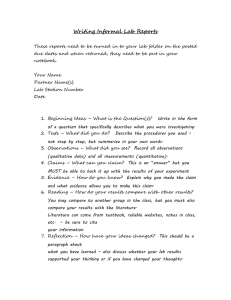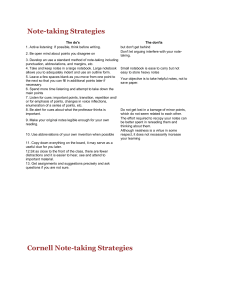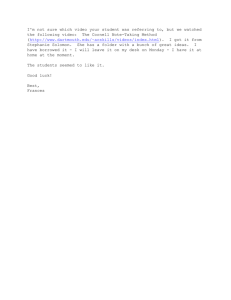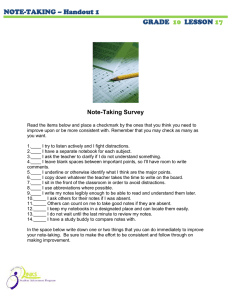Taking Notes GRADE
advertisement
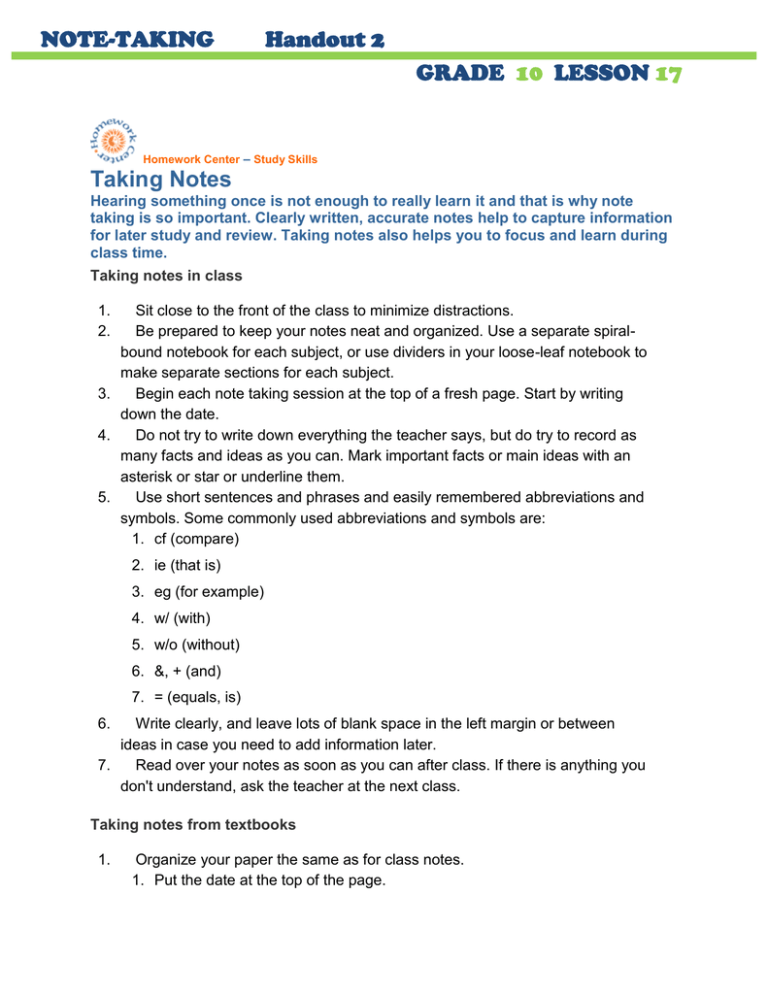
NOTE-TAKING Handout 2 GRADE 10 LESSON 17 Homework Center – Study Skills Taking Notes Hearing something once is not enough to really learn it and that is why note taking is so important. Clearly written, accurate notes help to capture information for later study and review. Taking notes also helps you to focus and learn during class time. Taking notes in class 1. 2. Sit close to the front of the class to minimize distractions. Be prepared to keep your notes neat and organized. Use a separate spiralbound notebook for each subject, or use dividers in your loose-leaf notebook to make separate sections for each subject. 3. Begin each note taking session at the top of a fresh page. Start by writing down the date. 4. Do not try to write down everything the teacher says, but do try to record as many facts and ideas as you can. Mark important facts or main ideas with an asterisk or star or underline them. 5. Use short sentences and phrases and easily remembered abbreviations and symbols. Some commonly used abbreviations and symbols are: 1. cf (compare) 2. ie (that is) 3. eg (for example) 4. w/ (with) 5. w/o (without) 6. &, + (and) 7. = (equals, is) 6. Write clearly, and leave lots of blank space in the left margin or between ideas in case you need to add information later. 7. Read over your notes as soon as you can after class. If there is anything you don't understand, ask the teacher at the next class. Taking notes from textbooks 1. Organize your paper the same as for class notes. 1. Put the date at the top of the page. 2. Write down the name of the book and the chapter or section you will be taking notes from. 3. Leave space in the left margin or between ideas for your own comments or questions. 2. Keep textbook notes separate from class notes. Use a separate notebook or a separate section in your loose-leaf notebook. 3. Get a general idea of what the reading is about. 0. Read the introduction, headings and subheadings, and any paragraphs that summarize the content. 1. Look at any illustrations or graphs and charts and read the captions. 4. 5. Go back and read the chapter or section carefully. Look for the main ideas. Try not to copy information directly from the textbook into your notes. Instead, summarize the information in your own words. This will help you to concentrate and learn. 6. If you do copy directly from the textbook, use quotation marks to indicate that it is a direct quotation. Take care to copy the quotation exactly. 7. Summarize the main ideas at the end of your notes and circle them. Source: Homework Center – Study Skills Taking Notes http://www.infoplease.com/homework/studyskills2.html Other helpful websites: Education World http://www.education-world.com/a_lesson/lesson/lesson322.shtml Academic Skills Center Dartmouth http://www.dartmouth.edu/~acskills/success/notes.html Prentice Hall Student Success Super Site http://www.prenhall.com/success/StudySkl/notetake.html The Cornell Note-Taking System http://ccc.byu.edu/learning/note-tak.php Teen’s Health Note-taking Tips http://kidshealth.org/teen/school_jobs/studysmart/take_notes.html
